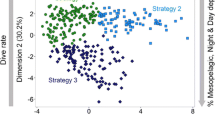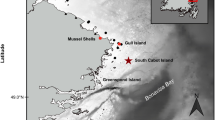Abstract
Owing to the necessity of delivering food to offspring at colonies, breeding seabirds are highly constrained in their foraging options. To minimize constraints imposed by central-place foraging and to optimize foraging behavior, many species exhibit flexible foraging tactics. Here we document the behavioral flexibility of pursuit-diving common murres Uria aalge when foraging on female capelin Mallotus villosus in the northwest Atlantic. Quite unexpectedly, being visual foragers, we found that common murres dived throughout the day and night. Twenty-one percent of recorded dives (n = 272 of 1,308 dives) were deep (≥50 m; maximum depth = 152 m, maximum duration = 212 s), bringing murres into sub-0°C water in the Cold Intermediate Layer (CIL; 40–180 m) of the Labrador Current. Deep dives occurred almost exclusively during the day when murres would have encountered spatially predictable aggregations of capelin between 100 and 150 m in the water column. Temperatures within the CIL shaped trophic interactions and involved trade-offs for both predators and prey. Sub-0°C temperatures limit a fish’s ability to escape from endothermic predators by reducing burst/escape speeds and also lengthening the time needed to recover from burst-type activity. Thus, while deep diving may be energetically costly, it likely increases certainty of prey capture. Decreased murre foraging efficiency at night (indicated by an increase in the number of dives per bout) reflects both lower light conditions and changing prey behavior, as capelin migrate to warmer surface waters at night where their potential to escape from avian predators could increase.








Similar content being viewed by others
References
Bailey RFJ, Able KW, Leggett WC (1977) Seasonal and vertical distribution and growth of juvenile and adult capelin (Mallotus villosus) in the St Lawrence Estuary and western Gulf of St Lawrence. J Fish Res Board Can 34:2030–2040
Benvenuti S, Dall’Antonia L, Falk K (2002) Diving behaviour differs between incubating and brooding Brünnich’s guillemots, Uria lomvia. Polar Biol 25:474–478
Burger AE (1991) Maximum diving depths and underwater foraging in alcids and penguins. In: Montevecchi WA, Gaston AJ (eds) Studies of high-latitude seabirds. 1. Behavioural, energetic, and oceanographic aspects of seabird feeding ecology, vol 68. Can Wild Serv Occas Pap, pp 9–15
Burger AE, Piatt JF (1990) Flexible time budgets in breeding common murres: buffers against variable prey abundance. Stud Avian Biol 14:71–83
Burger AE, Simpson M (1986) Diving depths of Atlantic puffins and common murres. Auk 103:828–830
Burke CM, Montevecchi WA (2008) Fish and chicks: forage fish and chick success in two co-existing auks. Waterbirds 31:372–384
Cairns DK, Gaston AJ, Huettmann F (2008) Endothermy, ectothermy and the global structure of marine vertebrate communities. Mar Ecol Prog Ser 356:239–250. doi:https://doi.org/10.3354/meps07286
Camphuysen CJ (ed) (2005) Understanding marine foodweb processes: an ecosystem approach to sustainable sandeel fisheries in the North Sea. IMPRESS Final Report. Royal Netherlands Institute for Sea Research, Texel
Chardine JW, Robertson GJ, Ryan PC, Turner B (2003) Abundance and distribution of common murres breeding at Funk Island, Newfoundland in 1972 and 2000, vol 404. Can Wild Ser Tech Rep Ser, Atlantic Region
Croll DA, Gaston AJ, Burger AE, Konnoff D (1992) Foraging behavior and physiological adaptation for diving in thick-billed murres. Ecology 73:344–356. doi:https://doi.org/10.2307/1938746
Davoren GK (2007) Effects of gill-net fishing on marine birds in a biological hotspot in the Northwest Atlantic. Conserv Biol 21:1032–1045. doi:https://doi.org/10.1111/j.1523-1739.2007.00694.x
Davoren GK, Montevecchi WA (2003a) Signals from seabirds indicate changing biology of capelin stocks. Mar Ecol Prog Ser 258:253–261. doi:https://doi.org/10.3354/meps258253
Davoren GK, Montevecchi WA (2003b) Consequences of foraging trip duration on provisioning behaviour and fledging condition of common murres Uria aalgae. J Avian Biol 34:44–53. doi:https://doi.org/10.1034/j.1600-048X.2003.03008.x
Davoren GK, Montevecchi WA, Anderson JT (2003a) Distributional patterns of a marine bird and its prey: habitat selection based on prey and conspecific behaviour. Mar Ecol Prog Ser 256:229–242. doi:https://doi.org/10.3354/meps256229
Davoren GK, Montevecchi WA, Anderson JT (2003b) Search strategies of a pursuit-diving marine bird and the persistence of prey patches. Ecol Monogr 73:463–481. doi:https://doi.org/10.1890/02-0208
Davoren GK, Anderson JT, Montevecchi WA (2006) Shoal behaviour and maturity relations of spawning capelin (Mallotus villosus) off Newfoundland: demersal spawning and diel vertical movement patterns. Can J Fish Aquat Sci 63:268–284. doi:https://doi.org/10.1139/f05-204
Domenici P, Claireaux G, McKenzie D (2007) Environmental constraints upon locomotion and predator–prey interactions in aquatic organisms: an introduction. Philos Trans R Soc B Biol Sci 362:1929–1936. doi:https://doi.org/10.1098/rstb.2007.2078
Drinkwater KF (1996) Atmospheric and oceanic variability in the Northwest Atlantic during the 1980s and early 1990s. J Northwest Atl Fish Sci 18:77–97. doi:https://doi.org/10.2960/J.v18.a6
Elliott KH, Davoren GK, Gaston AJ (2007) The influence of buoyancy and drag on the dive behaviour of an Arctic seabird, the thick-billed murre. Can J Zool 85:353–361. doi:https://doi.org/10.1139/Z07-012
Elliott KH, Woo K, Gaston AJ, Benvenuti S, Dall’Antonia L, Davoren GK (2008a) Seabird foraging behaviour indicates prey type. Mar Ecol Prog Ser 354:289–303. doi:https://doi.org/10.3354/meps07221
Elliott KH, Davoren GK, Gaston AJ (2008b) Time allocation by a deep-diving bird reflects prey type energy gain. Anim Behav 75:1301–1310. doi:https://doi.org/10.1016/j.anbehav.2007.09.024
Falk K, Benvenuti S, Dall’Antonia L, Kampp K, Ribolini A (2000) Time allocation and foraging behaviour of chick-rearing Brünnich’s guillemots Uria lomvia in high-arctic Greenland. Ibis 142:82–92. doi:https://doi.org/10.1111/j.1474-919X.2000.tb07687.x
Falk K, Benvenutti S, Dall’Antonia L, Gilchrist G, Kampp K (2002) Foraging behaviour of thick-billed murres breeding in different sectors of the North Water polynya: an inter-colony comparison. Mar Ecol Prog Ser 231:293–302. doi:https://doi.org/10.3354/meps231293
Fridolfsson A-K, Ellegren H (1999) A simple and universal method for molecular sexing of non-ratite birds. J Avian Biol 30:116–121. doi:https://doi.org/10.2307/3677252
Halsey LG, Bost CA, Handrich Y (2007) A thorough and quantified method for classifying seabird diving behaviour. Polar Biol 30:991–1004. doi:https://doi.org/10.1007/s00300-007-0257-3
Harding AMA, Piatt JF, Schmutz JA, Shultz MT, Van Pelt TI, Kettel AB, Speckman SG (2007) Prey density and the behavioural flexibility of a marine predator: the common murre (Uria aalge). Ecology 88:2024–2033. doi:https://doi.org/10.1890/06-1695.1
Huin N, Prince PA (1997) Diving behaviour of the grey-headed albatross. Antarct Sci 9:243–249. doi:https://doi.org/10.1017/S0954102097000321
Jodice PGR, Roby DD, Suryan RM, Irons DB, Turco KR, Brown ED, Thedinga JF, Visser GH (2006) Increased energy expenditure by a seabird in response to higher food abundance. Mar Ecol Prog Ser 306:283–293. doi:https://doi.org/10.3354/meps306283
Jones IL, Rowe S, Carr SM, Fraser G, Taylor P (2002) Different patterns of parental effort during chick-rearing by female and male thick-billed murres (Uria lomvia) at a low-arctic colony. Auk 119:1064–1074. doi:https://doi.org/10.1642/0004-8038(2002)119[1064:DPOPED]2.0.CO;2
Kieffer JD (2000) Limits to exhaustive exercise in fish. Comp Biochem Physiol A 126:161–179
Mehlum F, Watanuki Y, Takahashi A (2001) Diving behaviour and foraging habits of Brünnich’s guillemots (Uria lomvia) in the High Arctic. J Zool (Lond) 255:413–423. doi:https://doi.org/10.1017/S0952836901001509
Montevecchi WA (2001) Interactions between fisheries and seabirds. In: Schrieber EA, Burger J (eds) Biology of marine birds. CRC Press, Boca Raton, pp 527–557
Mowbray F (2002) Changes in the vertical distribution of capelin (Mallotus villosus) off Newfoundland. ICES J Mar Sci 59:942–949. doi:https://doi.org/10.1006/jmsc.2002.1259
Nakashima BS (1992) Patterns in coastal migration and stock structure of capelin (Mallotus villosus). Can J Fish Aquat Sci 49:2423–2429
Nakshima BS, Wheeler JP (2002) Capelin (Mallotus villosus) spawning behaviour in Newfoundland waters. ICES J Mar Sci 59:909–916. doi:https://doi.org/10.1006/jmsc.2002.1261
Nevins HM (2004) Diet, demography, and diving behaviour of the common murre (Uria aalge) in central California. MSc thesis, San Francisco State University
Orians GH, Pearson NE (1979) On the theory of central place foraging. In: Horn DJ, Mitchell RJ, Stairs GR (eds) Analysis of ecological systems. Ohio State University Press, Columbus, pp 154–177
Petrie B, Akenhead S, Lazier J, Loder J (1988) The cold intermediate layer on the Labrador and Northeast Newfoundland Shelves, 1978–86. NAFO Sci Counc Stud 12:57–69
Piatt JF (1990) The aggregative response of common murres and Atlantic puffins to their prey. Stud Avian Biol 14:36–51
Piatt JF, Nettleship DN (1985) Diving depths of four alcids. Auk 102:293–297
RASC (2007) Observers handbook 2008. In: Kelly P (ed) Royal Astronomical Society of Canada, Toronto
Raymond JA, Hassell A (2000) Some characteristics of freezing avoidance in two osmerids, rainbow smelt and capelin. J Fish Biol 57:1–7
Regehr HM, Montevecchi WA (1997) Interactive effects of food shortage and predation on breeding failures of black-legged kittiwakes: indirect effects of fisheries activities and implications for indicator species. Mar Ecol Prog Ser 155:249–260. doi:https://doi.org/10.3354/meps155249
Regehr HM, Rodway MS (1999) Seabird breeding performance during two years of delayed capelin arrival in the Northwest Atlantic: a multi-species comparison. Waterbirds 22:60–67. doi:https://doi.org/10.2307/1521994
Robertson GJ, Wilhelm SI, Taylor PA (2004) Population size and trends of seabirds breeding on Gull and Great Islands, Witless Bay Islands Ecological Reserve, Newfoundland, up to 2003. Can Wild Serv Tech Rep Ser 418, Atlantic Region
Rose GA, Leggett WC (1990) The importance of scale to predator–prey spatial correlations: an example of Atlantic fishes. Ecology 71:33–43. doi:https://doi.org/10.2307/1940245
SAS INSTITUTE (2005) SAS/STAT User’s guide, version 9.1.2. SAS Institute, Inc., Cary
Tremblay Y, Cherel Y, Oremus M, Tveraa T, Chastel O (2003) Unconventional ventral attachment of time-depth recorders as a new method for investigating time budget and diving behaviour of seabirds. J Exp Biol 206:1929–1940. doi:https://doi.org/10.1242/jeb.00363
United Nations Foundation (UN) (2007) UN Atlas of the Oceans. https://doi.org/www.oceansatlas.org/unatlas/about/physicalandchemicalproperties/background/seemore2.html (November 6, 2007)
Videler JJ, Wardle CS (1991) Fish swimming stride by stride: speed limits and endurance. Rev Fish Biol Fish 1:23–40. doi:https://doi.org/10.1007/BF00042660
Wanless S, Morris A, Harris MP (1988) Diving behaviour of guillemot Uria aalge, puffin ratercula arctica and razorbill Alca torda as shown by radio-telemetry. J Zool (Lond) 216:73–81
Wanless S, Finney SK, Harris MP, McCafferty DJ (1999) Effect of diel light cycle on the diving behaviour of two bottom feeding marine birds: the blue-eyed shag Phalacrocorax atriceps and the European shag P. aristotelis. Mar Ecol Prog Ser 188:219–224. doi:https://doi.org/10.3354/meps188219
Weimerskirch H, Ancel A, Caloin M, Zahariev A, Spagiari J, Kersten M, Chastel O (2003) Foraging efficiency and adjustment of energy expenditure in a pelagic seabird provisioning its chick. J Anim Ecol 72:500–508. doi:https://doi.org/10.1046/j.1365-2656.2002.00720.x
Weimerskirch H, Gault A, Cherel Y (2005) Prey distribution and patchiness: Factors in foraging success and efficiency of wandering albatrosses. Ecology 86:2611–2622. doi:https://doi.org/10.1890/04-1866
Wilson RP, Puetz K, Bost CA, Culik BM, Bannasch R, Reins R, Adelung D (1993) Diel dive depth in penguins in relation to diel vertical migration of prey: whose dinner by candlelight? Mar Ecol Prog Ser 94:101–104. doi:https://doi.org/10.3354/meps094101
Wilson RP, Steinfurth A, Ropert-Coudert Y, Kato A, Kurita M (2002) Lip-reading in remote subjects: an attempt to quantify and separate ingestion, breathing and vocalization in free-living animals using penguins as a model. Mar Biol (Berl) 140:17–27. doi:https://doi.org/10.1007/s002270100659
Winters GH (1970) Biological changes in coastal capelin from the over-wintering to the spawning condition. J Fish Res Board Can 27:2215–2224
Acknowledgments
We thank Gail Davoren, Don Deibel, Garth Fletcher, Jack Lawson, Laura McFarlane-Tranquilla, Steven Peake, Paulette Penton, and Becky Sjare for discussions and helpful comments. We thank Dawn Marshall and Steven Carr for molecular sexing of the murres. Nick White and Peter Mallum helped with the field work at Gull Island. Research was supported by grants to W. A. M. from NSERC, the Murre Fund of the Newfoundland and Labrador Legacy Nature Trust and the Government of Canada’s Program for International Polar Year.
Author information
Authors and Affiliations
Corresponding author
Additional information
Communicated by R. Lewison.
Rights and permissions
About this article
Cite this article
Hedd, A., Regular, P.M., Montevecchi, W.A. et al. Going deep: common murres dive into frigid water for aggregated, persistent and slow-moving capelin. Mar Biol 156, 741–751 (2009). https://doi.org/10.1007/s00227-008-1125-6
Received:
Accepted:
Published:
Issue Date:
DOI: https://doi.org/10.1007/s00227-008-1125-6




